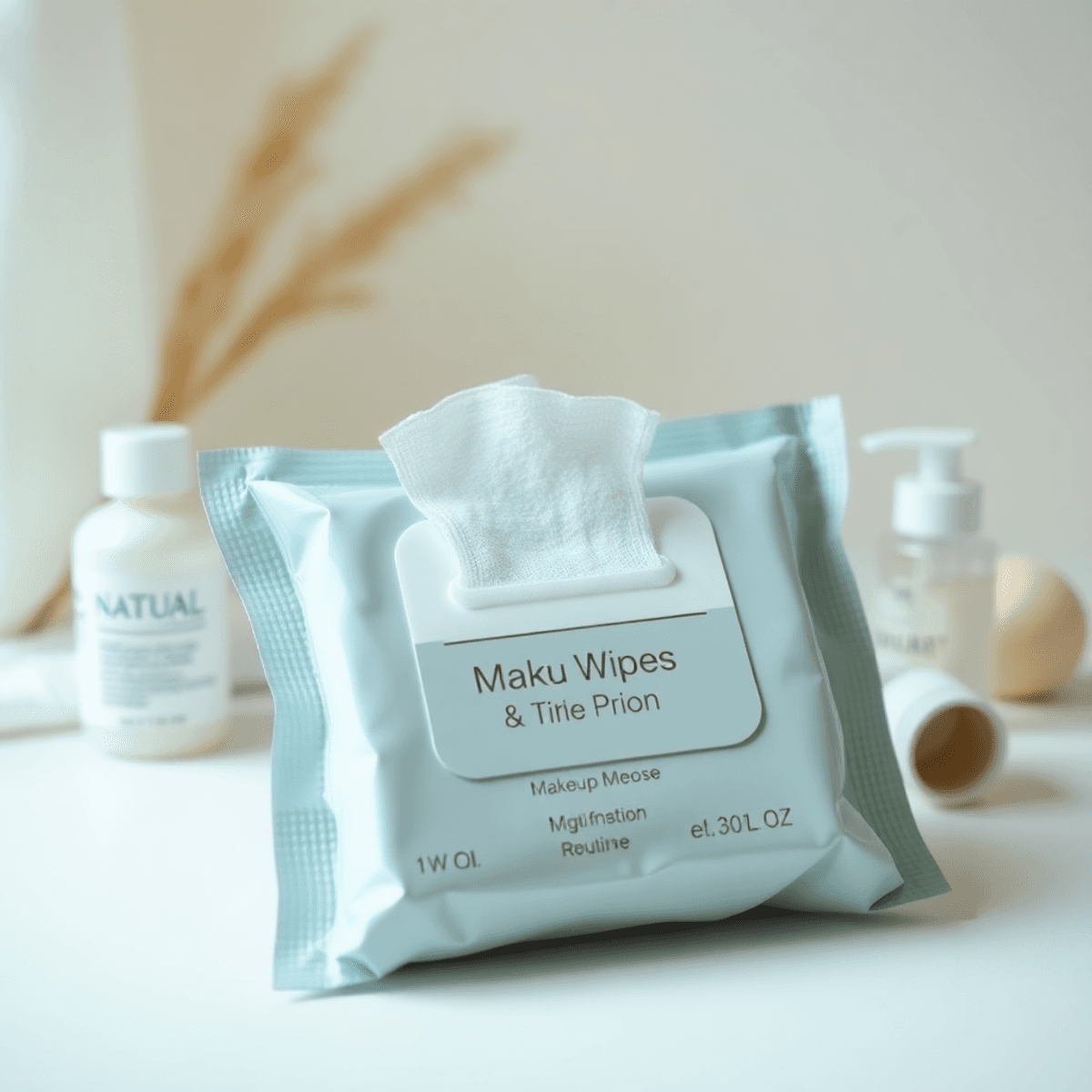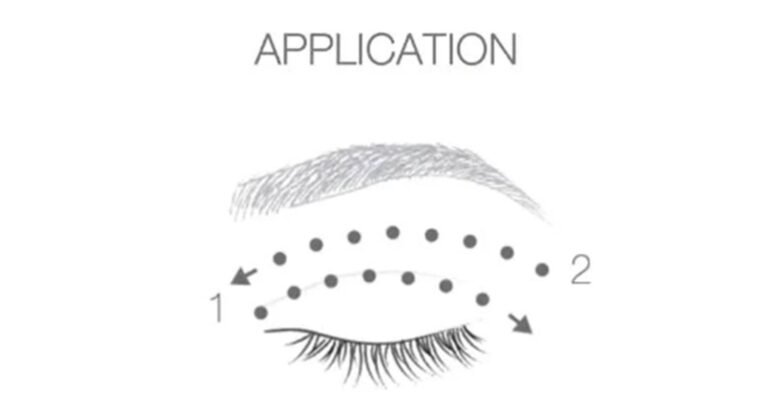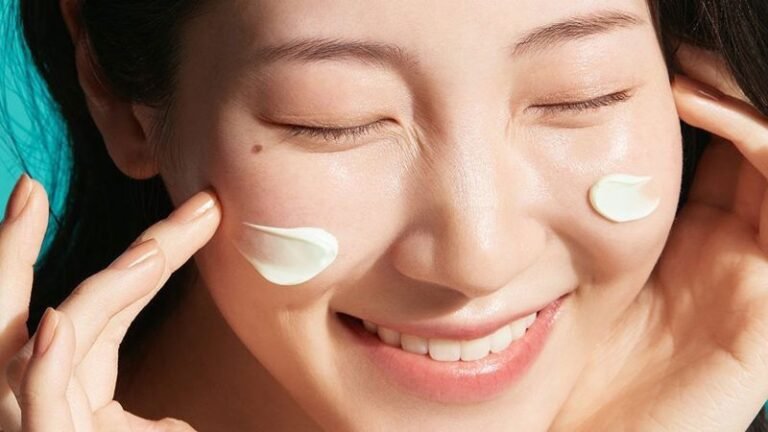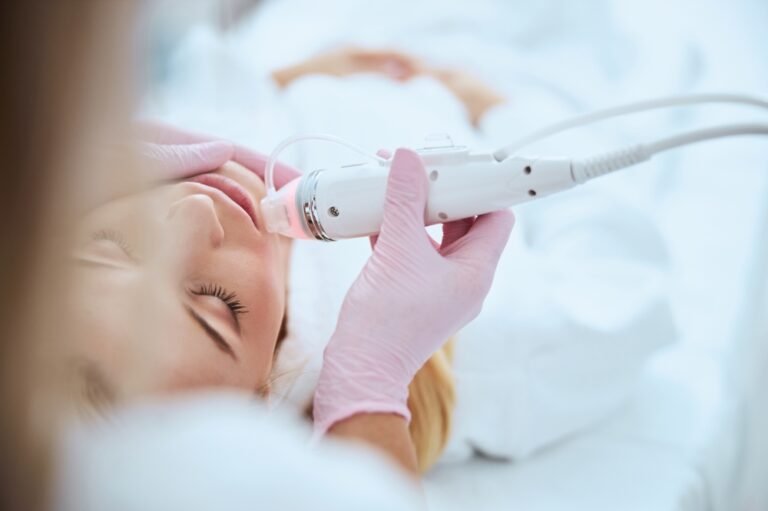Can Makeup Wipes Replace Your Cleanser? Dermatologists Weigh In

Introduction
Imagine this: You’ve just come back home after a long day, tired and ready to sleep. The idea of going through your entire skincare routine feels overwhelming. Those makeup wipes on your nightstand look so tempting.
You’re not the only one. Makeup wipes have become a must-have in many beauty routines, promising a quick and easy solution to removing makeup. Their portability and simplicity make them especially attractive for busy people, travelers, and gym-goers.
But here’s what dermatologists want you to know: if you rely only on makeup wipes for cleansing your skin, it might actually be doing more harm than good.
Dr. Sarah Chen, a board-certified dermatologist, explains:
“While makeup wipes can remove surface-level makeup and debris, they often leave behind residue that can clog pores and lead to breakouts. They’re not designed to provide the deep cleansing your skin needs.”
The convenience of makeup wipes comes with potential risks:
- Incomplete removal of makeup
- Buildup of residue on the skin
- Increased chances of clogged pores
- Possible irritation of the skin
- Disruption of the skin’s natural balance
Understanding these limitations is crucial for maintaining healthy skin. The question isn’t whether you should completely stop using makeup wipes – it’s about knowing how to properly incorporate them into your skincare routine.
Understanding Makeup Wipes
Makeup wipes are single-use cloths saturated with cleansing solutions designed to remove makeup, dirt, and oil from your skin. These portable beauty tools have gained widespread popularity due to their grab-and-go nature and minimal storage requirements.
Key Components of Makeup Wipes:
- Base Material: Typically made from non-woven fabrics like polyester, wood pulp, or rayon
- Cleansing Agents: Surfactants that break down makeup and oils
- Emollients: Ingredients like glycerin or propylene glycol that prevent the wipes from drying out
- Preservatives: Compounds such as parabens or phenoxyethanol that maintain product stability
The cleansing mechanism of makeup wipes relies on both physical and chemical actions. The textured cloth provides mechanical exfoliation while the embedded solution dissolves makeup and impurities. Research has shown that these surfactants are particularly effective on cellulosic surfaces, which is a common base material in many makeup wipes. You’ll find different formulations tailored to specific needs:
Common Ingredients by Wipe Type:
- Oil-Based Wipes: Mineral oil, Isopropyl palmitate, Caprylic/capric triglycerides
- Water-Based Wipes: Aqua, Polysorbates, Cetearyl alcohol
- Micellar Wipes: Micelle-forming surfactants, Gentle cleansing compounds, Hydrating ingredients
The manufacturing process involves carefully balancing these ingredients to create a stable product that maintains its effectiveness throughout its shelf life. Brands often incorporate additional active ingredients like aloe vera, vitamin E, or chamomile to provide extra skincare benefits.
Travel-friendly packaging makes these wipes particularly appealing for gym bags, overnight stays, or long-haul flights. The individually wrapped versions offer extra convenience and prevent the remaining wipes from drying out. You’ll find options ranging from basic cleansing wipes to specialized formulations targeting specific skin concerns like acne or sensitivity.
The Limitations of Makeup Wipes
Makeup wipes provide a surface clean at best, failing to deliver the deep cleansing your skin needs. When you swipe a makeup wipe across your face, you’re essentially pushing dirt, oil, and makeup around rather than removing them completely. This action can drive these impurities deeper into your pores, creating a perfect environment for breakouts and skin irritation.
The residue left behind by makeup wipes creates several issues for your skin:
- Product Build-up: Many wipes leave behind a film of cleansing agents and preservatives
- Trapped Debris: Makeup particles and environmental pollutants can remain stuck in your pores
- Moisture Barrier Disruption: The rubbing motion combined with residual chemicals can compromise your skin’s natural defense system
Research shows that relying solely on makeup wipes can lead to:
- Clogged Pores: The combination of leftover makeup and wipe residue creates blockages
- Bacterial Growth: Trapped debris provides an ideal breeding ground for acne-causing bacteria
- Premature Aging: The physical dragging of wipes can stretch your skin
- Increased Sensitivity: Regular exposure to residual chemicals may trigger reactions
Your skin requires proper emulsification to break down makeup, sunscreen, and daily grime effectively. Makeup wipes lack this crucial process, as they don’t contain enough cleansing agents to dissolve these substances properly. The physical wiping motion also doesn’t match the effectiveness of washing with water, which helps lift and rinse away impurities.
Users with acne-prone skin face particular risks when using makeup wipes as their primary cleansing method. The incomplete removal of makeup and skincare products can create a cycle of breakouts, leading to increased inflammation and potential scarring. Even those with resilient skin may notice dullness, texture changes, or unexplained breakouts when relying too heavily on these convenient but limited tools.
Moreover, it’s important to note that some makeup wipes may contain harmful ingredients that could potentially mix poorly with certain metalworking fluids, leading to adverse reactions on the skin.
Chemical Concerns with Makeup Wipes
The convenience of makeup wipes comes at a potential cost to your skin health. These products contain various chemicals designed to keep them moist, preserve their shelf life, and break down makeup effectively.
Common Preservatives Found in Makeup Wipes:
- Phenoxyethanol
- Methylparaben
- Propylparaben
- Benzyl alcohol
- Methylisothiazolinone (MIT)
These preservatives prevent bacterial growth and extend product longevity, but they can trigger skin sensitivities in many users. MIT, particularly, has been linked to contact dermatitis and rashes in sensitive individuals.
Active Ingredients That May Cause Irritation:
- Sodium lauryl sulfate
- Fragrance additives
- Alcohol-based compounds
- Propylene glycol
- Formaldehyde-releasing preservatives
The combination of these chemicals creates a harsh environment for your skin. When you wipe these substances across your face, you’re not just removing makeup – you’re leaving behind a residue of potentially irritating compounds.
Research indicates that fragrance additives rank among the top allergens in skincare products. Many makeup wipe brands include artificial fragrances to create a pleasant scent, yet these additions serve no cleansing purpose and may trigger allergic reactions.
Signs of Chemical Sensitivity:
- Redness
- Burning sensation
- Itching
- Skin peeling
- Increased dryness
- Rash development
The alcohol content in many wipes can disrupt your skin’s natural barrier function. This disruption makes your skin more susceptible to environmental stressors and increases the likelihood of irritation from other skincare products.
Pre-moistened wipes require stronger preservatives than traditional cleansers due to their constant exposure to air and moisture. These preservation methods, while necessary for product stability, create a higher risk of skin reactions compared to traditional cleansing methods.
Expert Opinions: What Dermatologists Say About Makeup Wipes vs. Cleansers
Leading dermatologists consistently emphasize the importance of proper skin cleansing routines. Dr. Sarah Mitchell, a board-certified dermatologist in New York, states:
“Your skin needs thorough cleansing to maintain its health. Makeup wipes simply drag debris across your face rather than lifting it away completely.”
Here’s what skincare professionals recommend:
- Double cleansing is essential – Dr. Jennifer Lee suggests using a dedicated makeup remover or cleansing oil before washing with a water-based cleanser
- Mechanical action matters – The rubbing motion required with makeup wipes can cause micro-tears in the skin
- Water is crucial – Traditional cleansers combined with water help dissolve both oil-based and water-based impurities
Research from the American Academy of Dermatology indicates that 87% of dermatologists advise against using makeup wipes as a primary cleansing method. Their concerns include:
- Incomplete makeup removal
- Residue left on skin
- Potential for bacterial growth
- Risk of premature aging due to repeated pulling and tugging
Dr. Michael Chen, a clinical researcher specializing in skincare, explains:
“While makeup wipes serve a purpose for emergencies or travel, they shouldn’t replace your daily cleansing routine. The mechanical action of proper washing with water helps stimulate blood flow and promotes cellular turnover.”
Professional guidance suggests specific cleansing techniques based on:
- Your skin type
- Current skin conditions
- Environmental factors
- Makeup usage patterns
Dermatologists recommend consulting with skincare professionals to develop a personalized cleansing routine that addresses your specific needs while maintaining skin barrier function.
The Two-Step Cleansing Method: A Compromise Between Convenience and Efficacy
The two-step cleansing process offers a practical solution that combines the convenience of makeup wipes with the thorough cleansing power of traditional facial cleansers. This method allows you to maintain healthy skin without sacrificing the ease of makeup removal.
Here’s how the two-step process works:
1. First Pass with Makeup Wipes
- Remove surface-level makeup and impurities
- Focus on stubborn areas like waterproof mascara
- Use gentle strokes to avoid skin irritation
2. Follow-Up with Traditional Cleanser
- Apply cleanser to damp skin
- Massage in circular motions for 60 seconds
- Rinse thoroughly with lukewarm water
This dual approach addresses several key skincare needs:
- Deep Pore Cleansing: The second cleansing step reaches deep into pores where makeup wipes can’t penetrate
- Removal of Residue: Traditional cleansers wash away any remaining makeup wipe residue
- Skin Barrier Protection: The proper cleansing step helps maintain your skin’s natural protective barrier
The two-step method proves particularly beneficial for:
- People who wear heavy makeup
- Those exposed to significant environmental pollutants
- Individuals with acne-prone skin requiring thorough cleansing
- Anyone seeking a balance between convenience and proper skincare
You’ll notice improved results by implementing this method:
- Clearer, brighter complexion
- Reduced likelihood of breakouts
- Better absorption of subsequent skincare products
- Maintained skin health without compromising convenience
The key lies in selecting compatible products for both steps. Your makeup wipes should align with your skin type, while your cleanser should complement your specific skincare needs.
Recommendations for Different Skin Types: Finding Suitable Products Within Your Skincare Routine
Your skin type plays a crucial role in determining the most effective cleansing routine. Let’s explore specific product combinations that work well for different skin concerns.
For Oily/Acne-Prone Skin: La Roche-Posay Effaclar Range and Neutrogena Oil-Free Cleansing Towelettes
The La Roche-Posay Effaclar range stands out as a powerhouse for oily and acne-prone skin types. Here’s what makes this combination particularly effective:
- Key Ingredients in Effaclar Range:Salicylic Acid (2%) – penetrates deep into pores to remove excess oil
- Zinc Pidolate – reduces surface oil production
- Micro-exfoliating LHA – gently removes dead skin cells
When paired with Neutrogena Oil-Free Cleansing Towelettes, you create a balanced cleansing routine that addresses multiple concerns:
- The wipes effectively remove surface-level makeup and impurities
- Their oil-free formula prevents additional oil buildup
- The gentle composition minimizes irritation during makeup removal
Real-world application: Start with a Neutrogena towelette to remove makeup, then follow with the Effaclar Medicated Gel Cleanser. This combination helps:
- Break down stubborn makeup and sunscreen
- Remove excess sebum
- Prevent new breakouts
- Maintain skin’s natural moisture barrier
The Effaclar Clarifying Solution contains both salicylic acid and glycolic acid, making it particularly effective for:
- Unclogging pores
- Reducing blackheads
- Minimizing the appearance of large pores
- Controlling oil production throughout the day
Many users report seeing improvements within 2-3 weeks of consistent use. The key is maintaining a gentle approach – even with oily skin, over-cleansing can trigger increased oil production.
- Use lukewarm water (hot water can stimulate oil production)
- Apply gentle pressure when using wipes
For Sensitive Skin: Cetaphil Gentle Skin Cleanser & Its Harmony With Simple Kind To Skin Cleansing Facial Wipes
Sensitive skin requires gentle, non-irritating products that won’t disrupt the skin’s delicate balance. Cetaphil Gentle Skin Cleanser stands out as a dermatologist-recommended option for reactive skin types. Its mild, soap-free formula contains just eight ingredients, making it less likely to trigger sensitivity reactions.
Key Benefits of Cetaphil Gentle Skin Cleanser:
- pH-balanced formula maintains skin’s protective barrier
- Free from fragrances and harsh surfactants
- Non-comedogenic composition prevents pore blockage
- Hydrating ingredients like glycerin help retain moisture
Simple Kind To Skin Cleansing Facial Wipes complement Cetaphil’s gentle approach perfectly. These wipes contain no artificial perfumes or harsh chemicals, making them suitable for sensitive skin types. The wipes’ soft texture prevents mechanical irritation while effectively removing surface-level makeup and impurities.
I’ve found this combination particularly effective for my sensitive skin. Using Simple’s wipes as an initial makeup removal step, followed by Cetaphil’s cleanser, creates a thorough yet gentle cleansing routine. The wipes remove visible makeup without stripping the skin, while Cetaphil’s cleanser ensures a deep clean without causing redness or irritation.
Recommended Usage Pattern:
- Start with Simple Kind To Skin wipes to remove visible makeup
- Apply Cetaphil cleanser to damp skin
- Massage gently in circular motions
- Rinse with lukewarm water
- Pat dry with a clean, soft towel
For extra-sensitive days, you can use Cetaphil’s cleanser with the “no-rinse” technique – simply apply and tissue off, minimizing potential irritation from water exposure.
Best Practices For Using Both Makeup Wipes And Cleansers Effectively In Your Skincare Routine
Creating a balanced skincare routine with both makeup wipes and cleansers requires strategic implementation. Here’s how you can maximize the benefits of both products:
1. Time Your Usage Correctly
- Use makeup wipes as your first step to remove surface-level makeup
- Wait 30 seconds before applying your cleanser
- Gentle circular motions work best for both products
2. Proper Application Techniques
- Hold the wipe against stubborn eye makeup for 10 seconds before wiping
- Use different sections of the wipe for different areas of your face
- Apply cleanser with damp hands to create a proper lather
3. Product Combination Guidelines
- Match your cleanser’s pH level with your makeup wipes
- Avoid wipes containing alcohol when using acid-based cleansers
- Space out active ingredients between your wipe and cleanser choices
4. Essential Safety Practices
- Perform a patch test on your inner arm 24 hours before trying new product combinations
- Watch for signs of irritation like redness, itching, or burning
- Stop use immediately if you experience adverse reactions
5. Temperature Considerations
- Use lukewarm water with your cleanser
- Store makeup wipes at room temperature
- Avoid exposing wipes to extreme heat or cold
Remember to listen to your skin’s response and adjust your routine accordingly. Different seasons or environmental changes might require modifications to your cleansing approach.
Conclusion: Striking A Balance Between Convenience And Care In Your Skincare Regimen
The question “Can makeup wipes replace your cleanser?” has a clear answer from dermatologists: No, but they can work together effectively.
Your skin deserves thoughtful care, even when time is limited. Here’s what a balanced approach looks like:
- Use makeup wipes strategically – perfect for gym bags, travel, or late nights
- Follow up with a proper cleanser when possible
- Listen to your skin’s responses and adjust accordingly
- Choose products that match your skin type and concerns
The key lies in viewing makeup wipes as a helpful tool rather than a complete solution. Think of them as the first step in your cleansing routine, not the only step.
Remember these essential points:
- Never sleep with makeup on – a quick wipe is better than nothing
- Keep both options readily available
- Consider your skin’s needs above convenience
- Invest in quality products that work for your skin type
A successful skincare routine balances practicality with effectiveness. By understanding the strengths and limitations of both makeup wipes and cleansers, you can create a routine that maintains healthy skin while fitting into your lifestyle.
Your skin is unique – experiment with different combinations and timings until you find what works best for you. The goal isn’t perfection but rather creating sustainable habits that keep your skin healthy and happy.
FAQs (Frequently Asked Questions)
Can makeup wipes replace my facial cleanser?
Dermatologists generally do not recommend relying solely on makeup wipes for skincare, as they may not effectively cleanse the skin and can potentially lead to issues such as clogged pores and irritation.
What are the limitations of using makeup wipes?
Makeup wipes may only provide a surface clean, leaving behind residue that can contribute to skin problems such as clogged pores and breakouts. They are not a substitute for a thorough cleansing routine.
Are there chemical concerns associated with makeup wipes?
Yes, many makeup wipes contain preservatives and other chemicals that can be potential skin irritants or allergens. It’s important to check the ingredient list to avoid adverse reactions.
What do dermatologists recommend regarding makeup wipes and cleansers?
The general consensus among dermatologists is that while makeup wipes can be convenient, they should not be used as a standalone cleansing method. A two-step cleansing process is often recommended for better efficacy.
How can I effectively use both makeup wipes and cleansers in my routine?
Incorporate a two-step cleansing method by first using a makeup wipe to remove makeup, followed by a traditional cleanser for a more thorough clean. Always patch test new combinations before fully committing.
What products are suitable for different skin types when using makeup wipes?
For oily/acne-prone skin, products like La Roche-Posay’s Effaclar range work well with Neutrogena oil-free cleansing towelettes. For sensitive skin, Cetaphil Gentle Skin Cleanser pairs nicely with Simple Kind To Skin Cleansing Facial Wipes.










